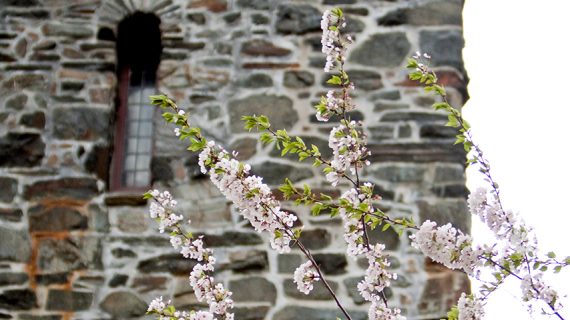Carillon Notes – Summer 2020
Tuesday, May, 5th, 2020 Announcements Carillon Tune

Carillon Notes for Summer 2020
Tune name: Pomp & Circumstance (Land of Hope and Glory)
It is commencement season in America (many other countries’ academic calendars are such that the year ends later in the summer) and the most commonly heard piece of music at graduations is Pomp and Circumstance. The full name of this composition is “Pomp and Circumstance March No. 1 in D Major” by Sir Edward Elgar, and more often than not only the trio section is used for procession. I thought that I would give some of the history behind this piece and why, though it is one of the most British pieces ever written, it is used for academic ceremonies in America.
Elgar actually completed five marches called Pomp and Circumstance and sketched a sixth which was assembled by composer Anthony Payne in 2005. The title comes from a speech in Act III, scene 3 of Shakespeare’s Othello:
Farewell the tranquil mind! farewell content!
Farewell the plumed troop, and the big wars,
That make ambition virtue! O, farewell!
Farewell the neighing steed, and the shrill trump,
The spirit-stirring drum, the ear-piercing fife,
The royal banner, and all quality,
Pride, pomp and circumstance of glorious war!
Elgar was uncharacteristically optimistic about the main theme of the first march, saying “I’ve got a tune that will knock ‘em — knock ‘em flat! …a tune like that comes once in a lifetime.” He wasn’t wrong. It was very well received at its Liverpool premiere in October 1901 and was given at one of Henry Wood’s “Promenade” concerts a few days later. The conductor wrote that the audience response was so enthusiastic that “for the one and only time in the history of the Promenade concerts an orchestral item was accorded a double encore.”
Elgar had not intended to set text to this tune, however popular it may have been, but he did set A.C. Benson’s text for the final section of his Coronation Ode for Edward VII in 1902, and it was sung by Dame Clara Butt, the great contralto for whom he also wrote his Sea Pictures. Elgar received £100 (equivalent to nearly £12,000/$15,000 today) for the publishing rights of this ode, and royalties of 5d (pennies) for every copy sold. The lyrics to the chorus are usually sung:
Land of Hope and Glory, Mother of the Free,
How shall we extol thee, who are born of thee?
Wider still and wider shall thy bounds be set;
God, who made thee mighty, make thee mightier yet.
The third line “wider still and wider” is problematic, as it refers to British Colonialism as exemplified by Cecil Rhodes (founder of the Rhodes scholarship) as “the extension of British rule throughout the world.” Benson actually revised the text twice, substituting “Truth and Right and Freedom, each a holy gem/Stars of solemn brightness weave thy diadem” in the Coronation Ode, and then “Gird thee well for battle, bid thy hosts increase/Stand for faith and honor, smite for truth and peace” in 1914. But it’s the first version that has stuck, and it is still sung this way at the Last Night of the Proms as it has been since 1905, and in many other places as well. Some English people consider it a secondary national anthem as “God Save the Queen” is the national anthem of the United Kingdom. Along with “Jerusalem,” “Land of Hope and Glory” usually tops the lists when Britons are asked about their favorite patriotic song.
So, when did it start being used as a graduation march? The answer is 1905, and the place was Yale University. Elgar had been invited to receive an honorary doctorate of music, and when Samuel Sanford, a professor in the music department, heard that the composer was coming from England to accept it, he arranged for the New Haven Symphony Orchestra, the Yale College Choir and Glee Club, and members of the music faculty to perform music of Elgar throughout the ceremony. Pomp and Circumstance was actually the last piece, played by the orchestra as the assembly left the hall. It was soon adopted by other American universities including Princeton (1907), University of Chicago (1908), Columbia (1913), Vassar (1916), Rutgers (1918), and by the 1920s it was being used at colleges and high schools all over the country and Canada. Tufts usually continues this tradition with a wind ensemble composed of students and alumni which plays the march as the graduating seniors and those receiving advanced degrees process to the Academic Quad.
My sincerest congratulations to the class of 2020 at Tufts and at all universities, hoping that this will do just a little bit to make your day special and add a bit of “pomp and circumstance” to it until we can gather safely in person once more.
Thomas Dawkins, University Chaplaincy Music Director
Further listening and viewing:
http://youtu.be/gLKSDT_2zPA Original orchestral version (with choral/audience participation) played by the BBC Symphony Orchestra conducted by Jiří Bělohlávek (the first non-native speaker of English to conduct this program) at Last Night of the Proms, 2012.
http://youtu.be/ATQH7bhy180 Jonathan Scott at the Grand Organ of the Royal Albert Hall, London, UK.
http://youtu.be/oQ_XDXDk96Q Dame Vera Lynn (still alive at the age of 103 as of this writing) sings a more popular version of “Land of Hope and Glory” in the early 1960s. Her singing of this and other patriotic songs was legendary during World War II.